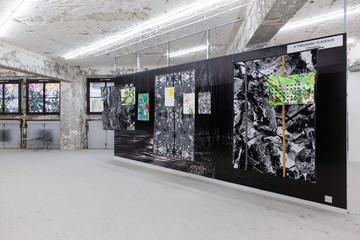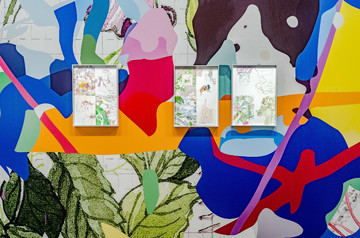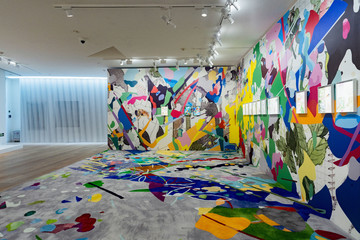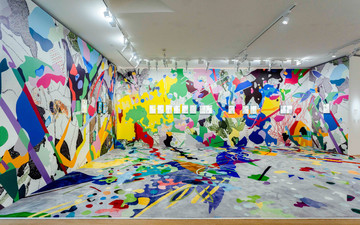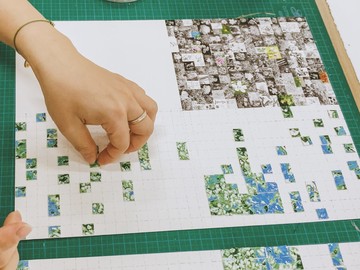For Paris Internationale 2023, A Thousand Plateaus will present a two person show with featured works by Bi Rongrong and Luo Mingjun. Presenting an interactive room decorated with ink on paper works, floating drawings and weavings, and a wallpaper that grows out from these drawings into the room, we will showcase a body of new work from Bi Rongrong’s “A Growing Landscape” series and a selection of ink works from Luo Mingjun’s “Break Up Star” Series.
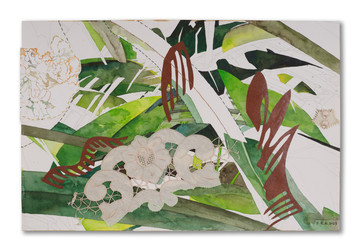
A Growing Landscape (IV) — manuscript 02
Pencil, watercolor,embroidery on cotton,polyester thread, Dong cloth (Botanical dyeing on cotton with surface brushed with egg white),
acid-free watercolor paper
36.5x55cm
2023
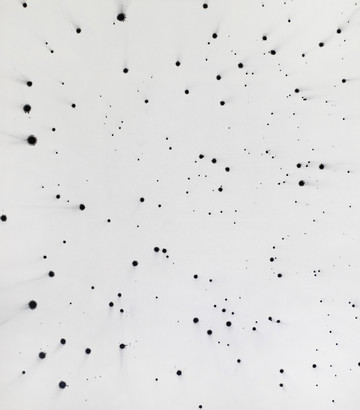
Luo Mingjun, Break Up Star - 136
Ink on rice paper mounted on cotton frame,
80 x 70 cm,
2020/2021
BI RONGRONG
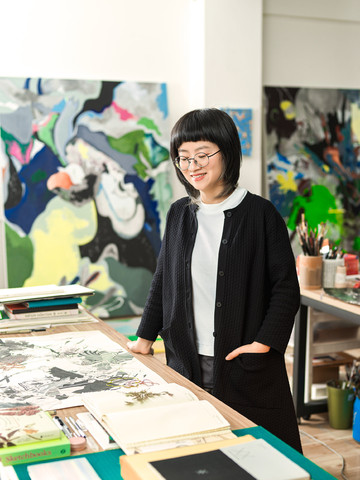
Artist Profile
Trained in traditional Chinese landscape painting and educated in contemporary art in the Netherlands, Bi Rongrong (b.1982) redefines the traditional concept of drawing and applies drawing-as-practice into physical places and virtual spaces.
As a trained Chinese painter who then chose to transition her craft into contemporary art, Bi Rongrong’s take on contemporary art is somewhat different and unique compared with her peers. She collects visual materials directly from her daily life and gradually comes up with a highly individualized module system during her drawing practice. The nature of her collecting is similar to sketching, a habit that she developed during her painting studies. Bi Rongrong collects visual images from local cities during her travels - such as the ornamental patterns on the architecture and the designs from graffiti and posters. She often takes photos of them and turns them into a personal modular archive - detaching them from their original context, taking out certain fragments and enlarging them to make her own pictorial modules. Then through different manual or digital processing, Bi Rongrong transforms her modules into a variety of mix media works including painting, collage, fabrics, video and site-specific installation. In the end, these applied fragmented patterns lose the original context but appear as another abstract form in her final work.
“In the “A Growing Landscape” series, I interpret images of plants collected from the internet and my daily surroundings. Then I decode and transform them through my paintings and textile works. The natural properties of plants and the environments in which they grow interact and relate to each other, and I found this relationship inspires and resembles to how us as human beings bind with ourselves and the nature. I try to make use of this relationship to bring the digital and pictorial materials I collected into a continuous dialogue with my environment. The process of constructing these materials can be described as “weaving”, which integrates paintings and fabrics into the space. This way of working gives the paintings and fabrics another possibility of freedom, and at the same time maps out my thoughts on the relationship between the environment and myself.”
—— Bi Rongrong
Learn more and download the project documentations here.pdf
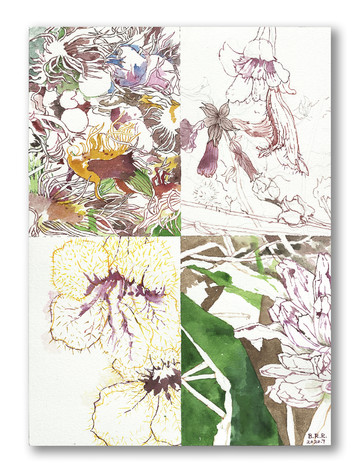
A Growing Landscape (IV) — manuscript 05
Pencil, watercolor, acid-free watercolor paper
25.5x35cm
2020
From collecting materials, to drawing, to developing the pieces into site-specific installations, drawing-as-practice becomes a way for Bi Rongrong to communicate with her surroundings and the world. It allows her work to live beyond one medium, growing into different spaces, and little by little transforming the life-based elements into the image landscape of another self.
Like a seed, her works start with a pattern and grows with the constant transformation of time and space, just as a thriving plant. And this time for Paris Internationale, Bi Rongrong continues her “A Growing Landscape” series to its fourth evolution - creating new body of work that extend beyond the drawings and weavings to spacial installations on the site-specific wall and windows - further shows the vitality of this continuing growth in her practice.
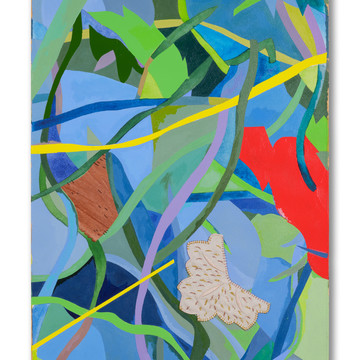
Watercolor, acrylic, embroidery on cotton,polyester thread, Dong cloth (Botanical dyeing on cotton with surface brushed with egg white),
acid-free watercolor paper
56x35.5cm
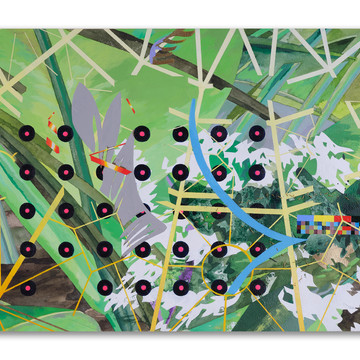
Watercolor, acrylic, acid-free watercolor paper
36.5x55cm
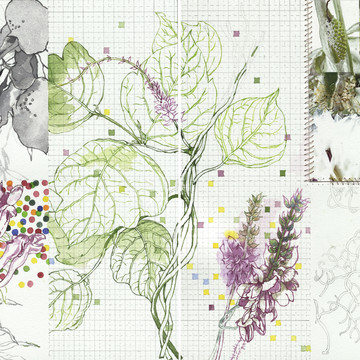
Pencil, watercolor, Ultra Giclee print, polyester thread, acid-free watercolor paper, 35x51cm
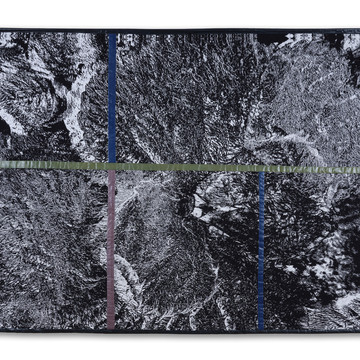
Jacquard fabric part: wool thread, cotton thread;
Fabric part: Dong cloth (Botanical dyeing on cotton with surface brushed with egg white)
155x114.5cm
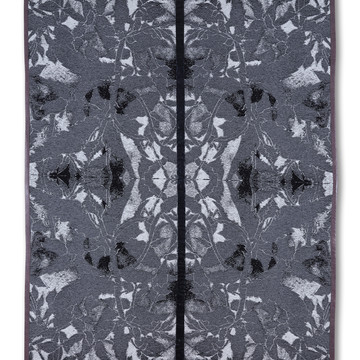
Jacquard fabric part: wool thread, cotton thread;
Fabric part: Dong cloth (botanical dyeing on cotton with surface brushed with egg white)
114x170cm
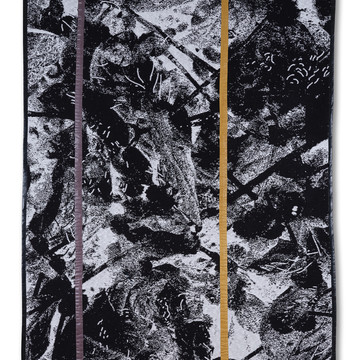
Jacquard fabric part: wool thread, cotton thread;
Fabric part: Dong cloth (botanical dyeing on cotton with surface brushed with egg white)
122.5x170cm
LUO MINGJUN
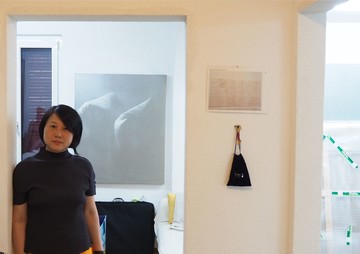
Artist Profile
In contrast with Bi Rongrong’s seed-like growing landscape, on rice paper individually mounted on wooden panels, Mingjun freed herself from calligraphy and dotted the square segments with randomly orchestrated ink marks, creating contemporary non-figurative works with techniques of traditional Chinese ink painting and framing.
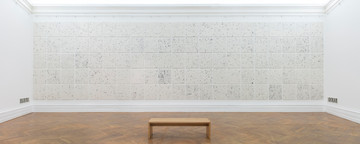
Luo Mingjun, Break Up Star
Installation View, Ink on rice paper mounted on cotton frame
80 x 70 cm x 105 pieces
2020/2021
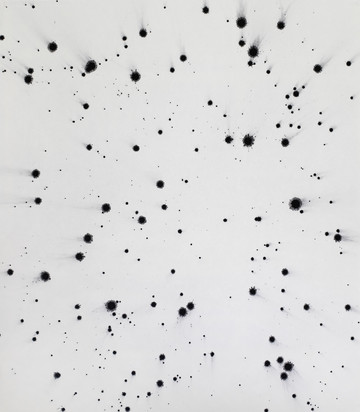
Luo Mingjun, Break Up Star - 156
Ink on rice paper mounted on cotton frame,
80 x 70 cm,
2020/2021
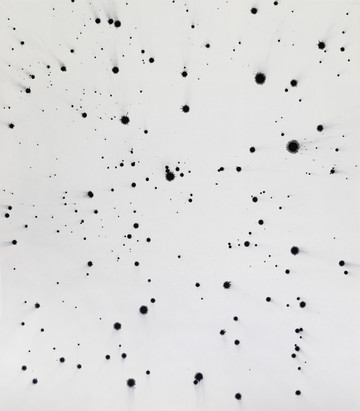
Luo Mingjun, Break Up Star - 157
Ink on rice paper mounted on cotton frame,
80 x 70 cm,
2020/2021
Born and raised in China, Mingjun Luo (b.1963) graduated from the Academy of Fine Arts of Hunan Normal University in 1983. As an assistant-teacher of drawing at the Academy of Fine Arts, she was awarded the Hunan Province Prize in 1984. In 1985, she founded the “0 Art Group”, a collective of avant-garde artists, with her fellow students. She arrived in Switzerland in 1987 and settled in Biel.
Mingjun Luo’s practice is an exploration of notions of identity and memory. Torn between Chinese and Western culture, she sees her work as a “third space”, a hybrid and fertile ground where she feeds off different traditions and develops her own language, in a continuous movement between Asia and the West. Since 2007, she has sought to capture the elusive aspect of memory in drawings based on family archives. Oscillating between reality and memory, the evanescent images evoke faded photographs, traces of a personal past.
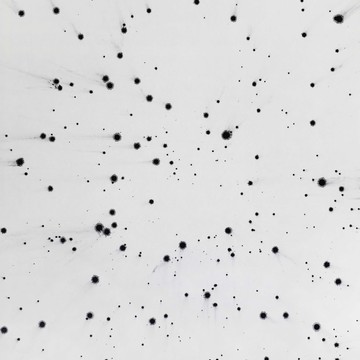
Ink on rice paper mounted on cotton frame,
80 x 70 cm
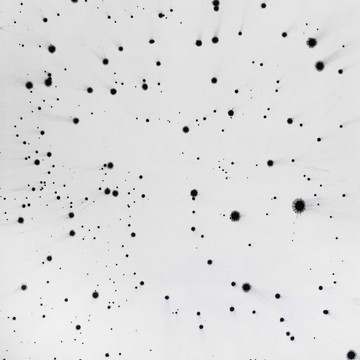
Ink on rice paper mounted on cotton frame, 80 x 70 cm
“Luo Mingjun laid out 40 sheets of rice paper mounted on the same amount of wood panels in four rows of ten elements. Liberated henceforth from calligraphy, she produced spots and stains of ink onto these square surfaces according to a random rhythm. The result was a work with a significant title - Break up -, with forty fragments of “constellations” impossible to reassemble into one single picture, for each element obeyed its own laws (of dispersal, of centrifugal movement, of dilution, etc.), and therefore rendered unique and impossible to copy or to reproduce. This liberating dripping allows the artist to move away from calligraphy and the classical Chinese landscape, with representation in short. Even if this technique refers to the traditional landscape style called “spattered ink”; it contributes towards creating an analytical artwork, by underlining the minimal ingredients of China ink: the dot of ink (which is an even smaller unit than a brushstroke) and the paper which is equivalent to the background. “
—— Bernard Fibicher
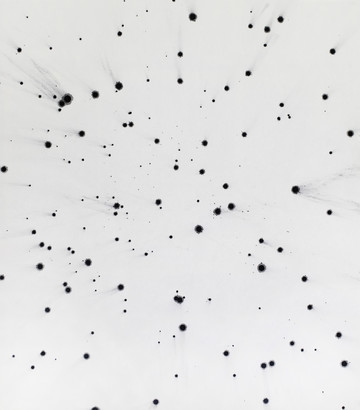
Luo Mingjun, Break Up Star - 145
Ink on rice paper mounted on cotton frame,
80 x 70 cm,
2020/2021

